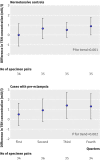Pre-eclampsia, soluble fms-like tyrosine kinase 1, and the risk of reduced thyroid function: nested case-control and population based study
- PMID: 19920004
- PMCID: PMC2778749
- DOI: 10.1136/bmj.b4336
Pre-eclampsia, soluble fms-like tyrosine kinase 1, and the risk of reduced thyroid function: nested case-control and population based study
Abstract
Objective: To determine if pre-eclampsia is associated with reduced thyroid function during and after pregnancy.
Design: Nested case-control study during pregnancy and population based follow-up study after pregnancy.
Setting: Calcium for Pre-eclampsia Prevention trial of healthy pregnant nulliparous women in the United States during 1992-5, and a Norwegian population based study (Nord-Trondelag Health Study or HUNT-2) during 1995-7 with linkage to the medical birth registry of Norway.
Participants: All 141 women (cases) in the Calcium for Pre-eclampsia Prevention trial with serum measurements before 21 weeks' gestation (baseline) and after onset of pre-eclampsia (before delivery), 141 normotensive controls with serum measurements at similar gestational ages, and 7121 women in the Nord-Trondelag Health Study whose first birth had occurred in 1967 or later and in whom serum levels of thyroid stimulating hormone had been subsequently measured.
Main outcome measures: Thyroid function tests and human chorionic gonadotrophin and soluble fms-like tyrosine kinase 1 concentrations in the Calcium for Pre-eclampsia Prevention cohort and odds ratios for levels of thyroid stimulating hormone above the reference range, according to pre-eclampsia status in singleton pregnancies before the Nord-Trondelag Health Study.
Results: In predelivery specimens of the Calcium for Pre-eclampsia Prevention cohort after the onset of pre-eclampsia, thyroid stimulating hormone levels increased 2.42 times above baseline compared with a 1.48 times increase in controls. The ratio of the predelivery to baseline ratio of cases to that of the controls was 1.64 (95% confidence interval 1.29 to 2.08). Free triiodothyronine decreased more in the women with pre-eclampsia than in the controls (case ratio to control ratio 0.96, 95% confidence interval 0.92 to 0.99). The predelivery specimens but not baseline samples from women with pre-eclampsia were significantly more likely than those from controls to have concentrations of thyroid stimulating hormone above the reference range (adjusted odds ratio 2.2, 95% confidence interval 1.1 to 4.4). Both in women who developed pre-eclampsia and in normotensive controls the increase in thyroid stimulating hormone concentration between baseline and predelivery specimens was strongly associated with increasing quarters of predelivery soluble fms-like tyrosine kinase 1 (P for trend 0.002 and <0.001, respectively). In the Nord-Trondelag Health Study, women with a history of pre-eclampsia in their first pregnancy were more likely than other women (adjusted odds ratio 1.7, 95% confidence interval 1.1 to 2.5) to have concentrations of thyroid stimulating hormone above the reference range (>3.5 mIU/l). In particular, they were more likely to have high concentrations of thyroid stimulating hormone without thyroid peroxidase antibodies (adjusted odds ratio 2.6, 95% confidence interval 1.3 to 5.0), suggesting hypothyroid function in the absence of an autoimmune process. This association was especially strong (5.8, 1.3 to 25.5) if pre-eclampsia had occurred in both the first and the second pregnancies.
Conclusion: Increased serum concentration of soluble fms-like tyrosine kinase 1 during pre-eclampsia is associated with subclinical hypothyroidism during pregnancy. Pre-eclampsia may also predispose to reduced thyroid function in later years.
Conflict of interest statement
Competing interests: SAK has served as a consultant to Abbott, Beckman Coulter, Roche, and Johnson & Johnson and has been named coinventor on multiple provisional patents filed by Beth Israel Deaconess Medical Center for the use of angiogenesis related proteins for the diagnosis and treatment of pre-eclampsia. These patents have been non-exclusively licensed to several companies.
Figures

Comment in
-
Subclinical hypothyroidism after pre-eclampsia.BMJ. 2009 Dec 8;339:b5183. doi: 10.1136/bmj.b5183. BMJ. 2009. PMID: 19995820 No abstract available.
References
-
- Redman CW, Sargent IL. Latest advances in understanding preeclampsia. Science 2005;308:1592-4. - PubMed
-
- Sibai B, Dekker G, Kupferminc M. Pre-eclampsia. Lancet 2005;365:785-99. - PubMed
-
- Hubel CA, Snaedal S, Ness RB, Weissfeld LA, Geirsson RT, Roberts JM, et al. Dyslipoproteinaemia in postmenopausal women with a history of eclampsia. Br J Obstet Gynaecol 2000;107:776-84. - PubMed
-
- Sibai BM, el-Nazer A, Gonzalez-Ruiz A. Severe preeclampsia-eclampsia in young primigravid women: subsequent pregnancy outcome and remote prognosis. Am J Obstet Gynecol 1986;155:1011-6. - PubMed
Publication types
MeSH terms
Substances
Grants and funding
LinkOut - more resources
Full Text Sources
Other Literature Sources
Medical
Miscellaneous
